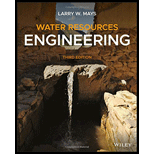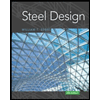
EBK WATER RESOURCES ENGINEERING
3rd Edition
ISBN: 9781119493167
Author: Mays
Publisher: VST
expand_more
expand_more
format_list_bulleted
Concept explainers
Question
Chapter 4, Problem 4.4.1P
To determine
Number of bolts required for the safe connection.
Expert Solution & Answer
Want to see the full answer?
Check out a sample textbook solution
Students have asked these similar questions
04
Q4
A waste effluent of 1.25 m/s with BOD, 183 mg/L, DO=0 mg/L and T
= 20 °C is to be discharged into a river of 8 m³/s flow, BOD, = 2mg/L, DO
-9.14 mg/L and T= 15 °C. At 20 °C, (K₁) is 0.3/day and (K2) is 0.9/day.
The average velocity of the river is 0.8 m/s. 1) Is DO min within the
environmental limitations? 2) At what distance is the maximum deficit
located. 3) Draw the oxygen sag curve? Given the saturation concentration
at 15 °C and at mixed temperature = 10.15 mg/L
Calculate 1- the effluent BOD, of a two-stage trickling filter with the
following flows, BOD, and dimensions? Q-5000 m³/day, influent
BOD,-280 mg/L, volume of first filter-1000 m³, volume of second
filter-800 m³, filter depth-2 m, r₁=1, z=1.25. Also, 2- calculate organic
loading rate (BOD, kg/day) 3- Hydraulic loading (m³/m²/d), 4- efficiency
of each stage 5- overall removal efficiency.
Q3: Determine the force in each member of the shown truss, and state whether they are tension
or compression.
40 kN
3 m
10 kN
A
25-1.25
m
m
-3.5 m-
3 m
B
Chapter 4 Solutions
EBK WATER RESOURCES ENGINEERING
Knowledge Booster
Learn more about
Need a deep-dive on the concept behind this application? Look no further. Learn more about this topic, civil-engineering and related others by exploring similar questions and additional content below.Similar questions
- Q3 Design a secondary clarifier for an activated sludge process with a recycle rate of 25 percent, a MLSS conc. 2500 mg/L, peak flow 9,000 m²/day, depth of tank 3 m and solid loading rate = 4 kg/m²/hrarrow_forwardA- Design grit removal chamber for a W.W.P with hourly flow equal 5000 m'h 410 markarrow_forward05 An average operating data for conventional activated sludge treatment plant is as follows: (1) Wastewater flow, Q-50000m/d (2) Volume of aeration tank, V-12000m (3) Influent BOD, Y.- 300 mg/1 (4) Effluent BOD, YE - 25 mg/1 (5) Mixed liquor suspended solids (MLSS), X₁ = 2500mg/1 (6) Effluent suspended solids, Xg30mg/1 (7) Waste sludge suspended solids, X-9700mg/1 (8) Quantity of waste sludge, Q., -220m³/d Based on the information above data, determine: (a) Aeration period (hrs.) (b) Food to microorganism ratio (F/M) (kg BOD per day/kg MLSS) (c) Percentage efficiency of BOD removal (d) Sludge age (days)arrow_forward
- Please solve the question by hand with a detailed explanation of the steps.arrow_forwardAn average operating data for conventional activated sludge treatment plant is as follows: (1) Wastewater flow, Q = 50000m³/darrow_forwardA- Design grit removal chamber for a W.W.P with hourly flow equal 5000 m'h B-Answer five of the following: 1-....... is the storm runoff that occurs from rainfall? (15 mark) (10 mark) 2- A protective device used to remove large and coarse materials from the wastewater 3-....... utilize a relative porous bacteria growth medium such as rock or formed plastic shapes 4- There are two basic methods of introducing air into the aeration tanks are....... And ......... 5-..... to water bodies such as rivers will be described by Streeter- Phelp's equation 6- .... is the liquid conveyed by a sewer, it may consist of any one or a mixture of liquid wastes.arrow_forward
- (2) Volume of aeration tank, V-12000m (3) Influent BOD, Y.- 300 mg/1 (4) Effluent BOD, Y, 25 mg/1 (5) Mixed liquor suspended solids (MLSS), X,-2500mg/1 (6) Effluent suspended solids, X-30mg/1 (7) Waste sludge suspended solids, XR-9700mg/1 (8) Quantity of waste sludge, Q., 220m³/d 100 Based on the information above data, determine: (a) Aeration period (hrs.) (b) Food to microorganism ratio (F/M) (kg BOD per day/kg MLSS) (c) Percentage efficiency of BOD removal (d) Sludge age (days)arrow_forwardWrite handwritten solution, answer a,b and c Refer to the soil profile shown in the Figure a. Calculate the variation of o, u, and o' with depth. b. If the water table rises to the top of the ground surface, what is the change in the effective stress at the bottom of the clay layer? c. How many meters must the groundwater table rise to decrease the effective stress by 15 kN/m? at the bottom of the clay layer?arrow_forwardWater is discharged into the atmosphere through a bent nozzle of an angle (a) as shown in the figure. The cross-sectional area at the nozzle inlet and outlet are (Ain) and (Aout), respectively. The discharge through the nozzle is (Q). The gauge pressure at the nozzle inlet is (Pin). The bend lies in a horizontal plane. Vin Ain Aout Atmosphere Vout Problem (9): Given the values of Ain [m²], Aout [m²], Pin [atm], Q [m³/s], and a [degrees], calculate the magnitude of the reaction force component in x-direction (Rx) in [N]. Givens: A in = 0.301 m^2 Aout Pin = 0.177 m^2 1.338 atm Q α = 0.669 m^3/s 37.183 degrees Answers: ( 1 ) 23028.076 N ( 2 ) 29697.962 N ( 3 ) 18633.611 N ( 4 ) 14114.988 Narrow_forward
- Please answer the following question in the picture and show all of your work please.arrow_forwardPlease answer the following questions and make sure you answer each question please.arrow_forwardWater is discharged into the atmosphere through a bent nozzle of an angle (a) as shown in the figure. The cross-sectional area at the nozzle inlet and outlet are (Ain) and (Aout), respectively. The discharge through the nozzle is (Q). The gauge pressure at the nozzle inlet is (Pin). The bend lies in a horizontal plane. Ain Vin Aout X Atmosphere Vout Problem (10): Given the values of Ain [m2], Aout [m²], Pin [atm], Q [m³/s], and a [degrees], calculate the magnitude of the reaction force component in y-direction (Ry) in [N]. Givens: A in 0.169 m^2 A out Pin 0.143 m^2 0.552 atm = Q α 0.367 m^3/s = 31.72 degrees Answers: ( 1 ) 6264.193 N (2) 12041.886 N ( 3 ) 8715.747 N ( 4 ) 7139.937 Narrow_forward
arrow_back_ios
SEE MORE QUESTIONS
arrow_forward_ios
Recommended textbooks for you
 Residential Construction Academy: House Wiring (M...Civil EngineeringISBN:9781337402415Author:Gregory W FletcherPublisher:Cengage Learning
Residential Construction Academy: House Wiring (M...Civil EngineeringISBN:9781337402415Author:Gregory W FletcherPublisher:Cengage Learning Materials Science And Engineering PropertiesCivil EngineeringISBN:9781111988609Author:Charles GilmorePublisher:Cengage Learning
Materials Science And Engineering PropertiesCivil EngineeringISBN:9781111988609Author:Charles GilmorePublisher:Cengage Learning Solid Waste EngineeringCivil EngineeringISBN:9781305635203Author:Worrell, William A.Publisher:Cengage Learning,
Solid Waste EngineeringCivil EngineeringISBN:9781305635203Author:Worrell, William A.Publisher:Cengage Learning, Engineering Fundamentals: An Introduction to Engi...Civil EngineeringISBN:9781305084766Author:Saeed MoaveniPublisher:Cengage Learning
Engineering Fundamentals: An Introduction to Engi...Civil EngineeringISBN:9781305084766Author:Saeed MoaveniPublisher:Cengage Learning Residential Construction Academy: House Wiring (M...Civil EngineeringISBN:9781285852225Author:Gregory W FletcherPublisher:Cengage Learning
Residential Construction Academy: House Wiring (M...Civil EngineeringISBN:9781285852225Author:Gregory W FletcherPublisher:Cengage Learning Steel Design (Activate Learning with these NEW ti...Civil EngineeringISBN:9781337094740Author:Segui, William T.Publisher:Cengage Learning
Steel Design (Activate Learning with these NEW ti...Civil EngineeringISBN:9781337094740Author:Segui, William T.Publisher:Cengage Learning

Residential Construction Academy: House Wiring (M...
Civil Engineering
ISBN:9781337402415
Author:Gregory W Fletcher
Publisher:Cengage Learning

Materials Science And Engineering Properties
Civil Engineering
ISBN:9781111988609
Author:Charles Gilmore
Publisher:Cengage Learning

Solid Waste Engineering
Civil Engineering
ISBN:9781305635203
Author:Worrell, William A.
Publisher:Cengage Learning,

Engineering Fundamentals: An Introduction to Engi...
Civil Engineering
ISBN:9781305084766
Author:Saeed Moaveni
Publisher:Cengage Learning

Residential Construction Academy: House Wiring (M...
Civil Engineering
ISBN:9781285852225
Author:Gregory W Fletcher
Publisher:Cengage Learning

Steel Design (Activate Learning with these NEW ti...
Civil Engineering
ISBN:9781337094740
Author:Segui, William T.
Publisher:Cengage Learning